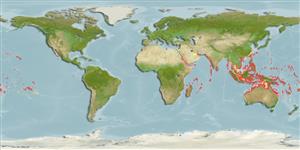Common names from other countries
Environment: milieu / climate zone / depth range / distribution range
экология
ассоциированный с рифами; пределы глубины 0 - 40 m (Ref. 848). Tropical; 28°N - 34°S, 26°E - 108°W (Ref. 848)
Indo-Pacific: Red Sea and eastern Africa, east to Easter Island, north to Ryukyu Islands, south to New Caledonia.
Length at first maturity / Size / Вес / Возраст
Maturity: Lm ? range ? - ? cm
Formation: spherical, columnar, hillocky or flat, may be several meters across. Corallites: evenly disturbed, conical, with thick walls and small openings. Costae: equal, well developed. Adjacent corallites do not join. A crown of paliform lobes often distinct. Uniform brown or green (Ref. 848).
Found in shallow reef environments with strong water movement (Ref. 848). In subtidal rock, rocky reefs, outer reef channel, back and foreslopes as well as lagoons (Ref. 98471).
Life cycle and mating behavior
половая зрелость | размножение | нерест | икра | Fecundity | личинки
Hermaphroditic (Ref. 113712). Mature gametes are shed into the coelenteron and spawned through the mouth. Life cycle: The zygote develops into a planktonic planula larva. Metamorphosis begins with early morphogenesis of tentacles, septa and pharynx before larval settlement on the aboral end (Ref. 833).
Основная ссылка
ссылки | координатор | соавторы
Ross, M.A. and G. Hodgson. 1981. (Ref. 8294)
Статус Красного Списка МСОП (Ref. 130435)
Статус СИТЕС (Ref. 108899)
Not Evaluated
Использование человеком
| FishSource |
инструменты
дополнительная информация
Возраст/РазмерыростЗависимость между длиной и массой телаЗависимость между длинамиморфологияличинкичисленность
ресурсы в Интернет
Estimates based on models
Preferred temperature
(Ref.
115969): 24.6 - 29, mean 28 (based on 886 cells).
Категория цены
Unknown.
